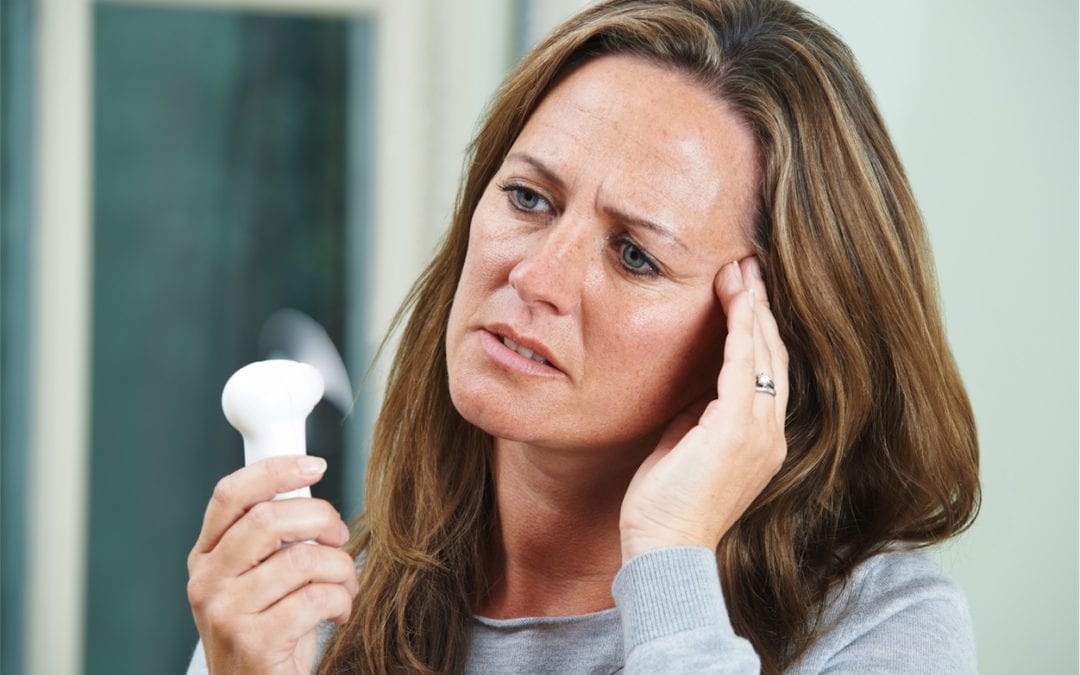As women wind down the reproductive phase of our lives hormone balances start to shift and we go through a peri-menopause transition averaging around 7 years until we reach menopause1. Medically, menopause is defined as the absence of a menstrual period for 12 months.
A common symptom during the peri-menopause phase are hot flushes. The duration and intensity of these are as individual as anything else about us. Some women will start getting them in their early-mid 30’s and will continue to get them until a few years after menopause, some get them a couple of years before and after menopause and some don’t get them until menopause and they continue for the rest of their lives 2.
Each individual flush episode can last between 5 minutes and 5 hours. Some women report a slight warming that is almost pleasurable, while others get intense heat and are covered in drenching sweat. Heart palpitations, pressure in head, rapid breathing and feelings of anxiety are also common. Women who have had their ovaries surgically removed or entered menopause due to side effects of cancer treatment may experience more intense symptoms 3. There is no predicting when they can occur and this can wreak havoc with sleep – night sweats leading to fatigue, brain fog and irritation. They can also be a challenge for women in their professional life. Imagine an important client meeting or presentation and an intense hot flush comes on. Not ideal for your confidence and poise.
What’s going on behind the scenes in a hot flush?
Hot flushes are a result of fluctuations in the hormones estrogen (estradiol) and progesterone. In early perimenopause hot flushes are driven by erratic progesterone caused by not always ovulating every month. You don’t make progesterone if you don’t ovulate. As perimenopause progresses decreasing and/or erratic fluctuations of estrogen are the culprit 4.
Estrogen and temperature control
Our body temperature is usually maintained within a very tight range and there are various control measures to do this including dilating blood vessels and moving blood from the internal organs to the skin (cooling the body). This makes you sweat. This process is controlled from the hypothalamus (brain) and uses hormones and neurotransmitters such as serotonin and noradrenalin as its messengers 5. Estrogen influences the production of serotonin and noradrenalin and stops it breaking down so fast. In early to mid perimenopause when estrogen is being crazy, unpredictable and spiking all over the place the poor hypothalamus can’t get a grip on where your temperature should be set so it overcompensates with a rapid, wild exaggerated responses that results in hot flushes. As menopause approaches the fluctuations of estrogen get less and decline to a consistent level. The hypothalamus can finally get a grip on the “new normal” and your temperature set points stabilise3.
5 natural ways to tame your hot flushes
Manage your stress so your adrenals can make estrogen
It’s important to remember that the loss of estradiol in menopause is from your ovaries, however small amounts are still produced in your adrenals. What other function do you adrenals also serve? They also help your body cope with stress via the hormones adrenalin, noradrenalin and cortisol. Your body views dealing with stress as a number 1 priority and will use your adrenals to deal with this in preference to producing estrogen. So one of the key foundations of hot flush minimisation is finding effective ways to reduce and manage stress. This allows your adrenals can get back to producing estrogen and the effects of the hot flushes will be lessened. The dial is turned down!
In addition to emotional and physical
Move your body
It’s probably no real surprise that maintaining
Balance your blood sugar
Clinical research indicates hot flushes occur 33% more frequently when blood sugar is unstable. Regulating insulin and blood glucose may reduce the occurrence of hot flushes 8. Choose a diet high in fibre and
In addition avoid/reduce substances that spike blood sugar such as caffeine, alcohol and refined sugar.
Are you sensing a theme here?
Eat Phytoestrogens
An overall dietary approach that includes healthy wholefoods will go a lot way to having a flush free/few menopause there are certain foods that can be particularly beneficial to include during this time. Phytoestrogens are plant substances that act in a similar manner to estrogen. They act by binding to the estrogen receptors albeit 100-1000 times less strongly then estradiol. This weak binding action helps to reduce the estrogen spikes 9.
There are 3 classes of phytoestrogens and some of the best food sources of these are:
Isoflavones: soybeans (tempeh, tofu, edamame), chickpeas and lentils
Lignans: flaxseed, whole grains, onions, garlic, apples, pears
Coumestans: alfalfa and soybean sprouts
Research has shown that having consistent levels in your body is more beneficial than one large dose. I recommend 2 serves a day of a variety of these foods. Benefits can be seen between 4-6 weeks 10.
Herbal Help – Sage the Saviour
As a
That said there is
Sage has a long folk history of treating excess sweating in menopause. It is also a tonic that is useful to counter the effects of mental and physical exhaustion -two other common issues for women navigating menopause. The traditional benefits of sage have been verified by recent clinical trials showing that taking sage for 8 weeks reduced hot flushes by between 46-79% 11.
One of the easiest ways to take sage is as a cold tea. The tea needs to be cooled otherwise sage acts in the opposite way increasing heat and sweating. Not what you want in menopause!
Sage Tea for Hot Flushes
- 2 heaped tablespoons of dried sage or 4 of freshly chopped sage
- 1 litre of water
Place in a saucepan and bring to the boil, reduce heat and simmer for 10 minutes. Turn heat off and let sit for another 15 minutes before straining and cooling to room temperature. If your hot flushes are severe you may want to chill it in the fridge as well.
Consume 4 cups over the course of the day. Use within 48 hours of making.
This tea will taste very strong so use honey or stevia to sweeten if required.
Sage is also available as a liquid extract that may be more convenient if you don’t like tea.
To some degree (no pun intended!) hot flushes are a part and parcel of the menopause transition and while the tips above may not eliminate them entirely they will help reduce how often, how long and how intense they are. With an average menopausal transition of 7
Move forward into the next phase of your life with energy, health and vitality!
References:
- Avis N, Crawford S,
Grendale G, Mromberger J. Duration of menopausal vasomotor symptoms over the menopause transition. J Am Med Assoc. 2015;175(4):2327–8.doi :10.1001/jama. - Zhou B, Sun X, Zhang M, Deng Y, Hu J. The symptomatology of climacteric syndrome: whether associated with the physical factors or psychological disorder in perimenopausal/postmenopausal patients with
anxiety-depression disorder. Arch Gynecol Obstet. 2012;285(5):1345–52.doi :10.1007/s00404-011-2151-z. Deecher DC, Dorries K. Understanding the pathophysiology of vasomotor symptoms (hot flushes and night sweats) that occur in perimenopause, menopause, and postmenopause life stages. ArchWomens Ment Health. 2007;10(6):247–57.doi :10.1007/s00737-007-0209-5.- Voorhis BJ Van, Santoro N, Harlow S, Ph D, Sybil L, Randolph J. Hormones in Women Approaching Menopause. Obs Gynecol. 2009;112(1):101–108.
doi :10.1097/AOG.0b013e31817d452b.The. - Andrikoula M, Baker D, Nesic J, Liao LM, Duka T, Prelevic GM. The effects of micronutrient supplementation on vasomotor symptoms in postmenopausal women. Climacteric. 2011;14(5):544–50.
doi :10.3109/13697137.2011.558951. - Romani WA, Gallicchio L, Flaws JA. The association between physical activity and hot flash severity, frequency, and duration in mid-life women. Am J Hum Biol. 2009;21(1):127–129.
doi :10.1002/ajhb.20834. - Chattha R, Nagarathna R, Padmalatha V, Nagendra HR. Effect of yoga on cognitive functions in climacteric syndrome: a randomised control study. Int J Obstet Gynaecol. 2008;115(8):991–1000. doi:10.1111/j.1471-0528.2008.01749.x.
- Dormire S,
Howharn C. The effect of dietary intake on hot flashes in menopausal women. J Obstet Gynecol Neonatal Nurs. 2009;36(3):255–62.doi :10.1111/j.1552-6909.2007.00142.x. - Philp HA. Hot flashes–a review of the literature on alternative and complementary treatment approaches. Altern Med Rev. 2003;8(3):284–302.
- Taku K, Melby MK, Kronenberg F, Kurzer MS, Messina M. Extracted or synthesized soybean isoflavones reduce
menopausal hot flash frequency and severity: systematic review and meta-analysis of randomized controlled trials. Menopause. 2012;19(7):776–90.doi :10.1097/gme.0b013e3182410159. - Bommer S, Klein P, Suter A. First time proof of sage’s tolerability and efficacy in menopausal women with hot flushes. Adv Ther. 2011;28(6):490–500.
doi :10.1007/s12325-011-0027-z.

Need help with navigating perimenopause?
Norelle Hentschel is an experienced Naturopath with a clinic in Stones Corner, Brisbane who enjoys supporting her clients to reach their health goals.
Want more articles like this?
Receive a monthly digest of natural health information to help you become “health” sufficient!
PS. Your inbox real estate is precious, and we will never annoy you with sales pitches or share your details with anyone else. One email a month — that’s it.

